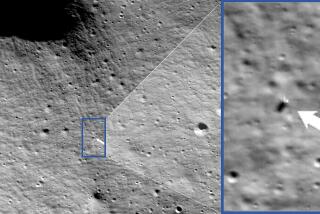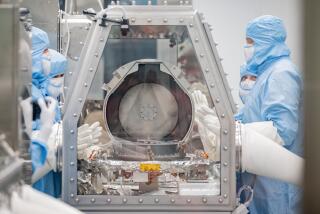NASA’s Mars Phoenix lander is really cooking now
- Share via
A last-ditch attempt to shake a sample of Martian soil into an oven on NASA’s Phoenix lander succeeded Wednesday, clearing the way for tests to determine whether the northern plains of Mars may once have been habitable.
“The group went up in cheers -- I got a standing ovation,” said William Boynton, the lead scientist on the vital instrument that will bake the Martian sample in a search for organic compounds.
Last week, the lander’s robotic arm dumped a pile of dirt on top of one of its eight tiny ovens. But the soil proved to be so clumpy that it failed to slide down a chute into the oven. The team of scientists repeatedly tried breaking up the clods by shaking the instrument, called the Thermal and Evolved-Gas Analyzer.
After six failures, the team at the University of Arizona and the Jet Propulsion Laboratory in La Cañada Flintridge made one last effort, Boynton said. When the shaking halted abruptly, the team thought the machine had failed. Then they discovered it had stopped because the oven was full.
As the scientists in Tucson cheered the result, Boynton put on the old disco tune “(Shake, Shake, Shake) Shake Your Booty” and started swaying to the music.
The histrionics among normally even-tempered scientists results from the fact that a failure with the TEGA could have doomed the $420-million mission. Although NASA has been sending spacecraft to other worlds for more than three decades, Phoenix is the first to search for water, the foundation of life as we know it. The craft landed on Mars on May 25 after a 296-day journey.
NASA’s Mars Odyssey spacecraft has detected large stores of ice at the poles, and Phoenix scientists think ice is only inches beneath the lander.
If the shaking method had failed to send the soil cascading into the oven, scientists were planning to scoop up a new batch of soil and trickle it into the chute instead of dumping it in a big clump. Peter Smith, the lead team member from the University of Arizona, said the scientists would use the trickle method for future deliveries to the other ovens.
Over a period of weeks, the ovens will heat up soil and ice samples and analyze the gases given off. Because different elements are emitted at different temperatures, the ovens will gradually increase the cooking temperature to 1,000 degrees Fahrenheit.
Analysis of the soil sample will not begin for a few days. Instead, the first results will come from a second instrument, the Microscopy, Electrochemistry and Conductivity Analyzer. The first microscope images of the soil could arrive today.
Scientists hope the pictures will help them figure out why the soil is different than what they expected. It appears to have a crusty layer on top and contains some ingredient, possibly water or salt, that causes it to form clods, Smith said.
“I’m quite excited” by the unusual nature of the soil, he said. The latest pictures, sent Tuesday, show two new trenches, dubbed Dodo and Baby Bear, dug by the scoop attached to the robotic arm. At the bottom of the trenches are whitish streaks that could indicate Phoenix has already reached the ice layer.
Some scientists are still doubters, however, and the difference of opinion has inspired some fevered debate.
Smith compared one argument Tuesday night to a baseball manager thrusting out his jaw while disputing an umpire’s call. “There was a little bit of a heated discussion,” he said.






